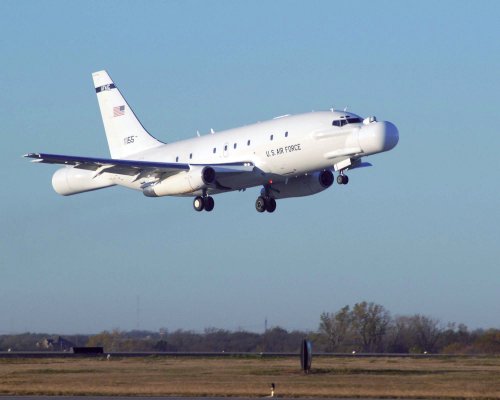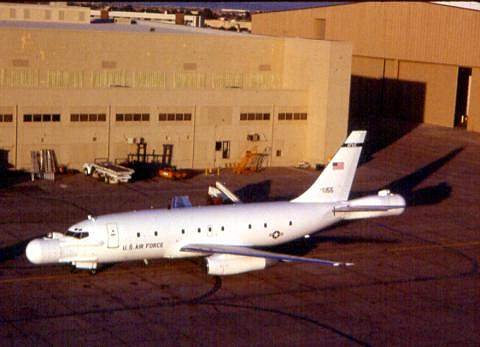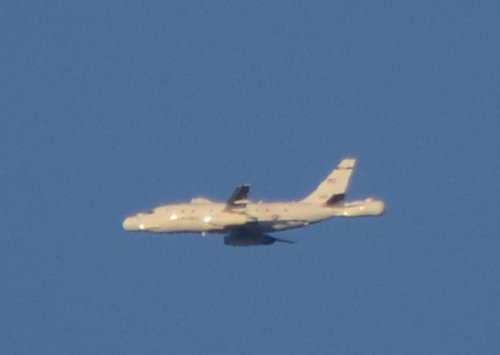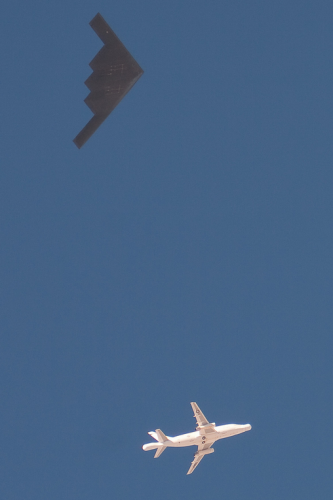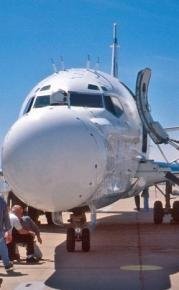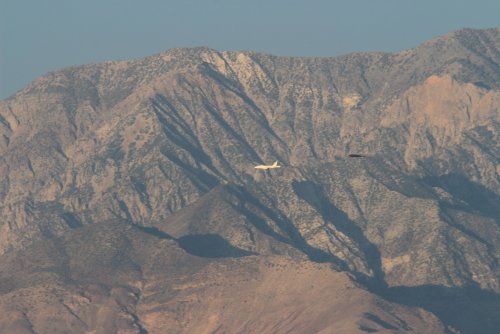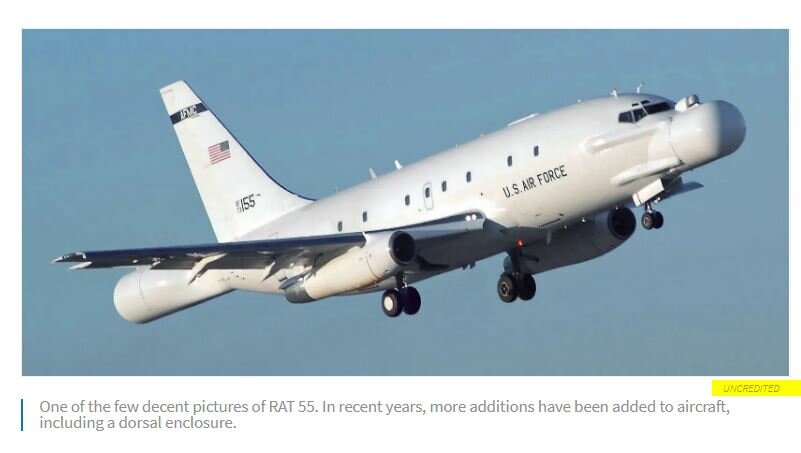- Joined
- 1 April 2006
- Messages
- 11,053
- Reaction score
- 8,512
Have found a nice photo of this quite sensitive bird, so have decided to collect bits from the net to post here for a reason.
The Air Force operates a modified NT-43A as a Radar Test Bed (RTB) with radar imaging gear on its nose and tail in radomes that are 9 feet long and over 6.5 feet in diameter. NT-43A Radar Test Bed, 73-1155 making radar images of a Northrop-Grumman B-2 Spirit at an altitude of about 7,000 feet over Death Valley on January 24, 2003. Death Valley is utilized as a natural radar test facility. It is over a mile deep and a hundred miles long, shielded from all radar transmitters, providing an environment free from radar interference.
The RTB is used to make radar images of stealthy aircraft. The images are used to evaluate the effectiveness of their stealth characteristics, to reveal the rate of degradation of the radar deflecting and absorbing components as the aircraft age, and to determine the effectiveness of maintenance and repair methods.
NT-43A, 73-1155 carries Boeing construction number 20702. It first flew on July 2, 1974 and was delivered to the Air Force ten days later. It served initially as a navigation trainer. It was retired from that role and delivered to AMARC on September 25, 1997. Identified as TH002, it was sealed with spraylat and sat in the desert sun for over two years. 73-1155 was selected for modification as the Radar Test Bed. It was pulled out of storage at AMARC and delivered to the Ogden Air Logistics Center (OO-ALC) at Hill Air Force Base, Utah for refurbishment on November 19, 1999.
 www.globalsecurity.org
73-1155 was flown to an aircraft maintenance and modification facility at Goodyear, Arizona in March 2000 for the installation of the enormous radomes on its nose and tail.
www.globalsecurity.org
73-1155 was flown to an aircraft maintenance and modification facility at Goodyear, Arizona in March 2000 for the installation of the enormous radomes on its nose and tail.
DENMAR, Inc. was the prime contractor for the modification of the NT-43A. It is run by Denys Overholser, who wrote the "Echo 1" software used to evaluate the stealth characteristics of the Have Blue and F-117A Stealth Fighter. Under contract to DENMAR, Inc., the Lockheed Skunk Works designed and fabricated the mounts for radar installations on the nose and tail (see attachment) of the RTB at Air Force Plant 42 on the grounds of the Palmdale Airport in California. The mounts are made primarily of carbon epoxy honeycomb sandwich with machined aluminum fittings. They are 16.5 feet long and 6.2 feet in diameter. After conversion, it was rolled out on February 22, 2001. Its first flight in its new configuration was flown on March 21, 2001.
The flight operations contractor for the NT-43A is EG&G, operator of the "Janet Airlines" 737s and former T-43As that are used to transport workers to and from secure facilities in the Nellis AFB ranges. The lack of public sightings of the RTB suggests that the NT-43A operates from one of those secure facilities. It was sighted inside a hangar at Goodyear in December 2004, but otherwise it is rarely seen.
In mid-2000 the Lockheed Martin Advanced Prototype Center, part of the Advanced Development Programs' (ADP) organization, handed over its first major deliverable -- a flight-worthy composite structure -- on the center's first design and fabrication contract. The structure, a 19-foot long, 6.2-foot diameter fairing and bulkhead assembly, was delivered to customer DENMAR Inc. The prime contractor Denmar is a company specializing in stealth technology. The "Den" stands for President Denys Overholser, the former Skunk Works engineer credited with devising the shape of the first stealth aircraft. The assembly provides an aerodynamic transition from the existing aft fuselage of a T-43 aircraft, a modified Boeing 737-200, to an oversized radome. The aircraft serves as a Radar Test Bed (RTB) for future Air Force programs. The design, fabrication and machining of the structure's components were all performed at Palmdale. The structure is made of a 90-percent carbon epoxy/honeycomb sandwich material, with machined aluminum parts, and houses an airborne radar assembly. The contract with DENMAR also included the design and fabrication of three radomes for the RTB aircraft. Each radome is more than 6.5 feet in diameter and 9 feet in length. Technical papers from Rome Lab reference a bistatic Advanced Airborne Surveillance system-originally due to be demonstrated in 2000, and a graphic in a Lincoln Lab briefing paper showed a bistatic radar with its transmitter mounted on a 737. The Advanced Radar Test Bed [ARTB] was based on a Lockheed NC-141 (tail number 61-2779).
The Air Force operates a modified NT-43A as a Radar Test Bed (RTB) with radar imaging gear on its nose and tail in radomes that are 9 feet long and over 6.5 feet in diameter. NT-43A Radar Test Bed, 73-1155 making radar images of a Northrop-Grumman B-2 Spirit at an altitude of about 7,000 feet over Death Valley on January 24, 2003. Death Valley is utilized as a natural radar test facility. It is over a mile deep and a hundred miles long, shielded from all radar transmitters, providing an environment free from radar interference.
The RTB is used to make radar images of stealthy aircraft. The images are used to evaluate the effectiveness of their stealth characteristics, to reveal the rate of degradation of the radar deflecting and absorbing components as the aircraft age, and to determine the effectiveness of maintenance and repair methods.
NT-43A, 73-1155 carries Boeing construction number 20702. It first flew on July 2, 1974 and was delivered to the Air Force ten days later. It served initially as a navigation trainer. It was retired from that role and delivered to AMARC on September 25, 1997. Identified as TH002, it was sealed with spraylat and sat in the desert sun for over two years. 73-1155 was selected for modification as the Radar Test Bed. It was pulled out of storage at AMARC and delivered to the Ogden Air Logistics Center (OO-ALC) at Hill Air Force Base, Utah for refurbishment on November 19, 1999.
T-43A
DENMAR, Inc. was the prime contractor for the modification of the NT-43A. It is run by Denys Overholser, who wrote the "Echo 1" software used to evaluate the stealth characteristics of the Have Blue and F-117A Stealth Fighter. Under contract to DENMAR, Inc., the Lockheed Skunk Works designed and fabricated the mounts for radar installations on the nose and tail (see attachment) of the RTB at Air Force Plant 42 on the grounds of the Palmdale Airport in California. The mounts are made primarily of carbon epoxy honeycomb sandwich with machined aluminum fittings. They are 16.5 feet long and 6.2 feet in diameter. After conversion, it was rolled out on February 22, 2001. Its first flight in its new configuration was flown on March 21, 2001.
The flight operations contractor for the NT-43A is EG&G, operator of the "Janet Airlines" 737s and former T-43As that are used to transport workers to and from secure facilities in the Nellis AFB ranges. The lack of public sightings of the RTB suggests that the NT-43A operates from one of those secure facilities. It was sighted inside a hangar at Goodyear in December 2004, but otherwise it is rarely seen.
In mid-2000 the Lockheed Martin Advanced Prototype Center, part of the Advanced Development Programs' (ADP) organization, handed over its first major deliverable -- a flight-worthy composite structure -- on the center's first design and fabrication contract. The structure, a 19-foot long, 6.2-foot diameter fairing and bulkhead assembly, was delivered to customer DENMAR Inc. The prime contractor Denmar is a company specializing in stealth technology. The "Den" stands for President Denys Overholser, the former Skunk Works engineer credited with devising the shape of the first stealth aircraft. The assembly provides an aerodynamic transition from the existing aft fuselage of a T-43 aircraft, a modified Boeing 737-200, to an oversized radome. The aircraft serves as a Radar Test Bed (RTB) for future Air Force programs. The design, fabrication and machining of the structure's components were all performed at Palmdale. The structure is made of a 90-percent carbon epoxy/honeycomb sandwich material, with machined aluminum parts, and houses an airborne radar assembly. The contract with DENMAR also included the design and fabrication of three radomes for the RTB aircraft. Each radome is more than 6.5 feet in diameter and 9 feet in length. Technical papers from Rome Lab reference a bistatic Advanced Airborne Surveillance system-originally due to be demonstrated in 2000, and a graphic in a Lincoln Lab briefing paper showed a bistatic radar with its transmitter mounted on a 737. The Advanced Radar Test Bed [ARTB] was based on a Lockheed NC-141 (tail number 61-2779).
TRANSPORT AIRCRAFT TECHNICAL SERVICES COMPANY, INC.
...a highly modified T-43A that was originally deliverved to the USAF as a Navigator trainer.
...what we call the Bill Clinton airplane -- big nose and you know what!) We provided the out-of-storage and pre-modification
work packages and provided oversight on the acquisition of up-graded JT8D-17 engines.
“Bill Clinton” ─ a USAF T-43A (B737-200) radar test airplane with a very large radar on the nose and another one on the tail (a prudent man does not fly head-on to another airplane to “look” at that airplane UP CLOSE!).

